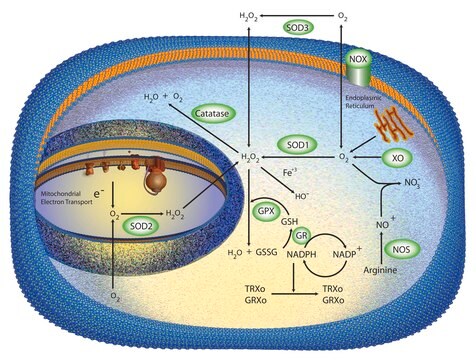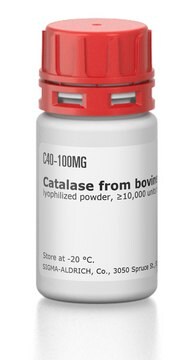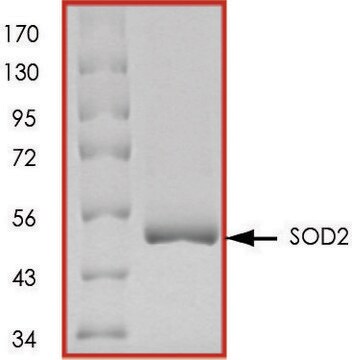S7571
Superoxide Dismutase from bovine erythrocytes
lyophilized powder, ≥3,000 units/mg protein, Protein ≥95 % by biuret
Sinonimo/i:
CU/ZN-SOD, Superoxide Dismutase 1 bovine, cytocuprein, erythrocuprein, hemocuprein, SOD, Superoxide: superoxide oxidoreductase
About This Item
Prodotti consigliati
Origine biologica
bovine
Stato
lyophilized powder
Attività specifica
≥3,000 units/mg protein
PM
32.5 kDa
Composizione
Protein, ≥95% biuret
Condizioni di stoccaggio
(Store under nitrogen.
Tightly closed. Dry.)
Caratteristiche più verdi
Atom Economy
Design for Energy Efficiency
Use of Renewable Feedstocks
Learn more about the Principles of Green Chemistry.
sustainability
Greener Alternative Product
tecniche
immunoblotting: suitable
inhibition assay: suitable
Colore
blue-green
pI
4.95
Solubilità
water: 20 mg/mL
aqueous buffer, pH 7.5: soluble
applicazioni
diagnostic assay manufacturing
Categoria alternativa più verde
Temperatura di conservazione
−20°C
Informazioni sul gene
cow ... SOD1(281495) , SOD2(281496)
Cerchi prodotti simili? Visita Guida al confronto tra prodotti
Categorie correlate
Descrizione generale
Superoxide dismutase (SOD) is a redox-active metalloenzyme expressed in both aerobic and anaerobic living organisms. Bovine superoxide dismutase or CuZn SOD is a homodimer with each subunit containing one zinc and one copper ion.
Applicazioni
- in a study to assess a kinetic model of radiation-induced inactivation of superoxide dismutase in nitrous oxide-saturated solutions
- in a study to investigate the possible participation of superoxide anion in the intestinal tryptophan 2,3-dioxygenase reaction
- to investigate its effect on the hemolysis rate of human RBCs and hemoglobin-nitric oxide complex (HbNO) stability in human erythrocytes
- in combination with catalase to study its effect on cell differentiation in vitro
- to quantify superoxide levels and study their effect on reactivity in mouse pulmonary arteries through chemiluminescence and cytochrome C reduction methods
Azioni biochim/fisiol
Definizione di unità
Stato fisico
Applicazioni
Prodotti correlati
Avvertenze
Danger
Indicazioni di pericolo
Consigli di prudenza
Classi di pericolo
Resp. Sens. 1
Codice della classe di stoccaggio
11 - Combustible Solids
Classe di pericolosità dell'acqua (WGK)
WGK 1
Punto d’infiammabilità (°F)
Not applicable
Punto d’infiammabilità (°C)
Not applicable
Dispositivi di protezione individuale
Eyeshields, Gloves, type N95 (US)
Scegli una delle versioni più recenti:
Possiedi già questo prodotto?
I documenti relativi ai prodotti acquistati recentemente sono disponibili nell’Archivio dei documenti.
I clienti hanno visto anche
Articoli
Oxidative stress is mediated, in part, by reactive oxygen species produced by multiple cellular processes and controlled by cellular antioxidant mechanisms such as enzymatic scavengers or antioxidant modulators. Free radicals, such as reactive oxygen species, cause cellular damage via cellular.
Protocolli
Enzymatic Assay of Superoxide Dismutase
Separation of Superoxide dismutase
Chromatograms
application for HPLCIl team dei nostri ricercatori vanta grande esperienza in tutte le aree della ricerca quali Life Science, scienza dei materiali, sintesi chimica, cromatografia, discipline analitiche, ecc..
Contatta l'Assistenza Tecnica.










